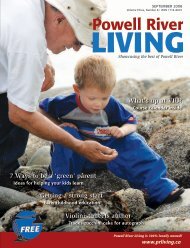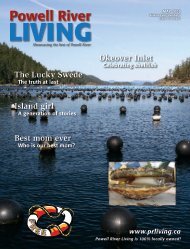Battle of the Dojos Personalized learning
op for... - Powell River Living
op for... - Powell River Living
- No tags were found...
You also want an ePaper? Increase the reach of your titles
YUMPU automatically turns print PDFs into web optimized ePapers that Google loves.
A growing concern<br />
By Jonathan van Wiltenburg • edenhort@gmail.com<br />
Dividing perennials<br />
Dividing herbaceous perennials is<br />
one <strong>of</strong> <strong>the</strong> most fruitful <strong>of</strong> all garden<br />
chores. Not only does it let you tame<br />
those fast growing border plants, but it<br />
also lets you increase your plant stock<br />
considerably which you can move around<br />
<strong>the</strong> garden or pass on to enthused neighbours<br />
and friends. It is remarkable to<br />
see how one plant can mo<strong>the</strong>r so many<br />
o<strong>the</strong>rs. Many new gardeners consider it<br />
an intimidating procedure, however, it is<br />
a relatively simple task that anyone can<br />
do. All it takes to have success is a bit <strong>of</strong><br />
courage, timing and <strong>the</strong> right tools.<br />
The first step, in any laborious task<br />
is finding <strong>the</strong> right tool for <strong>the</strong> job. For<br />
this task it would be wise to secure a<br />
nice sharp spade. A spade is a flat square<br />
nosed shovel that is primarily used for<br />
this purpose. Many <strong>of</strong> <strong>the</strong>m have short<br />
handles so it is easy to dig around shrubs<br />
and trees. The spade is <strong>the</strong> perfect tool<br />
because it can slice through tough plant<br />
material with ease.<br />
Once you have secured your spade,<br />
find <strong>the</strong> favoured specimen that needs<br />
splitting. Most herbaceous perennials respond<br />
very well to being split up. Plants<br />
like ferns, daylilies, phlox, nepeta, hosta,<br />
grasses, and asparagus all lend <strong>the</strong>mselves<br />
well to being split in <strong>the</strong> spring. In general,<br />
<strong>the</strong> rules for timing are as follows; species<br />
flowering mid to late summer (June-October)<br />
are split and divided early in spring.<br />
Plants flowering early (March-May) are<br />
split up in <strong>the</strong> fall. This gives <strong>the</strong>m adequate<br />
time to settle and establish <strong>the</strong>mselves<br />
before <strong>the</strong> next flowering cycle.<br />
Priorities for March<br />
• Tune-up all tools and machines: sharpening,<br />
cleaning, oiling and purging <strong>the</strong> useless.<br />
• Secure and apply compost, well-rotted manure,<br />
or seaweed to enhance <strong>the</strong> nutrient and<br />
organic matter content <strong>of</strong> your soil. A 5-10 cm<br />
top-dress would be great.<br />
• As soon as soil can be worked (ie not too wet)<br />
begin turning over <strong>the</strong> garden. Mix in <strong>the</strong> wellrotted<br />
composts.<br />
• Get organized. Construct a seed-sowing<br />
schedule. Sketch out your garden plot and<br />
plan your rotation. Figure out what needs to<br />
be planted when and how <strong>of</strong>ten. The seed<br />
package and <strong>the</strong> Internet will help.<br />
• Indoors, sow your heat lovers, tomatoes, peppers,<br />
eggplants, cucumbers and some summer<br />
annual flowers <strong>the</strong> sooner <strong>the</strong> better!<br />
• Outdoors, when <strong>the</strong> soil is workable consider<br />
sowing greens, peas, lettuces, spinach,<br />
summer cabbages, parsnips, carrots, beets,<br />
potatoes and chard.<br />
• Prune <strong>the</strong> shrub roses. Remember <strong>the</strong>y<br />
respond well to harder pruning.<br />
• Cut down ferns, grasses and o<strong>the</strong>r perennials<br />
that have been left as winter interest.<br />
• Get a head start on <strong>the</strong> weeding.<br />
• If you’re going to plant bare root plants, March<br />
is <strong>the</strong> opportune time. This includes fruit trees,<br />
roses and o<strong>the</strong>r ornamental specimens.<br />
How to divide herbaceous perennials<br />
1 Begin by taking <strong>the</strong> spade and slicing<br />
into <strong>the</strong> ground all <strong>the</strong> way around <strong>the</strong><br />
plant, avoiding trying to lift it from <strong>the</strong><br />
bed at this point. Once you have made<br />
all your cuts around, shove your spade<br />
in deep and begin to lift out <strong>the</strong> crown.<br />
If <strong>the</strong> procedure is done right it will<br />
come out like a blocky mass <strong>of</strong> soil<br />
and roots. If you have really sandy soil<br />
this will be more difficult.<br />
2 Next, place it on flat workable surface. A<br />
flat area <strong>of</strong> lawn will work nicely. I usually<br />
put a tarp down to avoid soil getting<br />
everywhere and to aid in clean up.<br />
3 Now, take your sharp spade and line it<br />
up in <strong>the</strong> center <strong>of</strong> <strong>the</strong> perennial. Give<br />
it a good swift stomp, and one piece becomes<br />
two. Repeat this procedure with<br />
<strong>the</strong> secondary clumps if necessary. If<br />
you find using your spade awkward,<br />
you can also use a root saw, or an old<br />
serrated knife. It is best to keep your<br />
pieces large enough to hold four to five<br />
new growing shoots per newly divided<br />
pieces. Trim <strong>of</strong>f any damaged roots.<br />
4 Lastly, replant. This can be in a pot,<br />
or back in <strong>the</strong> garden bed. Digging in<br />
some bone meal and some well-rotted<br />
compost would be a welcome addition.<br />
If you do plan to replant in ground, be<br />
mindful to replant at <strong>the</strong> same depth in<br />
<strong>the</strong> soil as it was prior to being dug up. It<br />
is really that easy! Happy gardening!<br />
Scan this QR code with your<br />
smart phone to sign up now!<br />
Visit mo<strong>the</strong>r-nature.ca and<br />
sign up for our e-newsletter,<br />
loaded with great coupons,<br />
sales and tips!<br />
Who knows better than Mo<strong>the</strong>r Nature?<br />
Krystaal Shzyourm RMT<br />
Registered Massage Therapist<br />
604 489-0200<br />
Now in: Summer blooming flower bulbs,<br />
onion sets, garlic, organic seeds<br />
and supplies<br />
Yes!<br />
Summer bulbs<br />
now in stock!<br />
7050 Duncan Street 604 485-9878<br />
Barbara Farquharson<br />
Registered Physio<strong>the</strong>rapist<br />
604 485-4439<br />
Kitty Clemens RHN<br />
Registered Holistic Nutritionist<br />
604 489-0200<br />
4585 Marine Avenue<br />
Please call for appointments or classes<br />
Hea<strong>the</strong>r Baldwin BSN<br />
Meditation Classes<br />
604 414-3611<br />
32 • www.PRLiving.ca

















